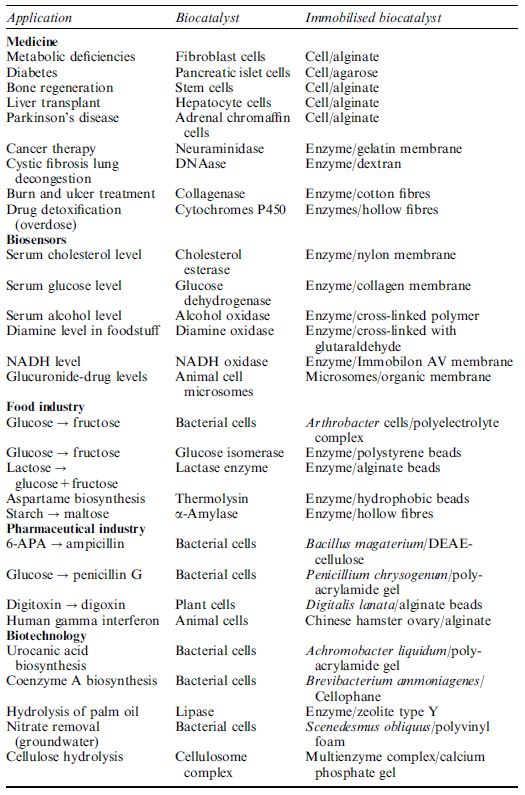


 النبات
النبات
 الحيوان
الحيوان
 الأحياء المجهرية
الأحياء المجهرية
 علم الأمراض
علم الأمراض
 التقانة الإحيائية
التقانة الإحيائية
 التقنية الحيوية المكروبية
التقنية الحيوية المكروبية
 التقنية الحياتية النانوية
التقنية الحياتية النانوية
 علم الأجنة
علم الأجنة
 الأحياء الجزيئي
الأحياء الجزيئي
 علم وظائف الأعضاء
علم وظائف الأعضاء
 الغدد
الغدد
 المضادات الحيوية
المضادات الحيوية|
Read More
Date: 9-1-2021
Date: 4-1-2021
Date: 4-1-2021
|
Applications of Immobilisation
Immobilisation technology is now firmly established among the tools used by biotechnologists to improve the effectiveness of biocatalysts for biotransformations in industry, analysis and medicine. Consequently, there are many examples of applications that use immobilised biocatalysts and further information can been obtained from reviews and books. A few examples are given in Table 1. to indicate the wide range. The future for immobilised biocatalysts is promising and exciting developments in this field will support the expected expansion and progress of biotechnology in various industries and medicine in the 21st century. Advances in nanotechnology have provided engineering tools to facilitate the development of enzyme-immobilised microchannel reactors that utilise microlitre and nanolitre fluidic systems for enzyme reactions.
Material engineers have produced highly defined nanoparticles that enable immobilised enzymes to be situated in defined fluidic microchannels for microscale reaction processes. Advances in the understanding and application of microfluidics will increase the scope for microscale reactions that have many advantages including substantial reduction of mass transfer effects and high enzyme loading. However, the debate surrounding the impact of bio-nanotechnology on society has started and, in the light of public understanding and reaction to genetically modified (GM) food, it is likely that biotechnologists will have an important role to play in ensuring that applications and impacts associated with environmental and health issues have a stronger profile in general discussions of the impact of bio-nanotechnology on society.
Table 1. Some applications of immobilised biocatalysts.




|
|
|
|
"عادة ليلية" قد تكون المفتاح للوقاية من الخرف
|
|
|
|
|
|
|
ممتص الصدمات: طريقة عمله وأهميته وأبرز علامات تلفه
|
|
|
|
|
|
|
ضمن أسبوع الإرشاد النفسي.. جامعة العميد تُقيم أنشطةً ثقافية وتطويرية لطلبتها
|
|
|